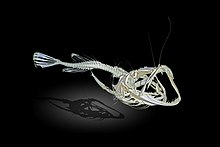ニシアンコウ
表示
| ニシアンコウ | ||||||||||||||||||||||||
|---|---|---|---|---|---|---|---|---|---|---|---|---|---|---|---|---|---|---|---|---|---|---|---|---|

| ||||||||||||||||||||||||
| 保全状況評価[1][2][3] | ||||||||||||||||||||||||
| LEAST CONCERN (IUCN Red List Ver.3.1 (2001)) 
| ||||||||||||||||||||||||
| 分類 | ||||||||||||||||||||||||
| ||||||||||||||||||||||||
| 学名 | ||||||||||||||||||||||||
| Lophius piscatorius Linnaeus, 1758 | ||||||||||||||||||||||||
| 英名 | ||||||||||||||||||||||||
| Angler Fishing-frog Frog-fish Sea-devil Monkfish | ||||||||||||||||||||||||

ニシアンコウ (Lophius piscatorius) はアンコウ科に属する魚類の一種。英語では Angler・fishing-frog・frog-fish・sea-devilなどと呼ばれる。
分布
[編集]
東大西洋の深度20-1000mに生息し、バレンツ海南西部からジブラルタル海峡・モーリタニアまで。地中海・黒海・アイスランドでも確認されている。北方の個体ほど大型になり、浅い場所に進出する傾向がある[4]。
形態
[編集]
最大体長2 m・57.7 kgに達するが、通常は1 m程度。背鰭は8棘11-12軟条、臀鰭は9-10軟条[4]。
形態は他のキアンコウ属とほぼ同じである。頭部は大きくて平たい。口は幅広く、内側を向いた細かい歯が並ぶ。胸鰭・腹鰭には柄があり、海藻などに隠れて海底を歩くことができる。背面は海藻に似た小さな皮弁で覆われ、体色は海底の色に似る。
生態
[編集]
他のキアンコウ属のように砂泥底に潜み、頭部の疑似餌を用いた"釣り"を行う[4]。成魚の獲物は北方ではノルウェーコダラ (Trisopterus esmarkii)、南方ではプタスダラ (Micromesistius poutassou) であるが、アイリッシュ海ではヨーロッパアカザエビやホワイティング、シェトランド諸島ではAmmodytes marinusなど、その場所・時期で利用できる獲物を無差別に捕食する[5]。
雄は49cm、雌は73cm程度で性成熟する。雌は卵巣上皮細胞から幅60cm、長さ10mに達するゼラチン質の膜を生成し卵を包み込む。このため、繁殖期には雌の体腔はほとんどこの物質で埋め尽くされている。産み出された卵塊には100万個に上る明るい橙色の卵が含まれる。これは水を吸って膨張し、表面に空いた細かい孔から精子が取り込まれて受精する[6]。幼生は浮遊性で腹鰭が長く伸びる。
最高で24歳の個体が報告されている[4]。
人との関連
[編集]アイリッシュ海などいくつかの海域では漁業上重要である[7]。鱗がないためカシュルートではない[8]。
脚注
[編集]- ^ Appendices I, II and III<https://cites.org/eng>(download 22/01/2020)
- ^ UNEP (2020). Chelonia mydas. The Species+ Website. Nairobi, Kenya. Compiled by UNEP-WCMC, Cambridge, UK. Available at: www.speciesplus.net. (download 22/01/2020)
- ^ Seminoff, J.A. (Southwest Fisheries Science Center, U.S.) 2004. Chelonia mydas. The IUCN Red List of Threatened Species 2004: e.T4615A11037468. https://doi.org/10.2305/IUCN.UK.2004.RLTS.T4615A11037468.en. Downloaded on 22 January 2020.
- ^ a b c d Froese, Rainer and Pauly, Daniel, eds. (2006). "Lophius piscatorius" in FishBase. April 2006 version.
- ^ Lophius in the world: a synthesis on the common features and life strategies, doi:10.1093/icesjms/fsn140
- ^ I. P. Afonso-Dias, J. R. G. Hislop, The reproduction of anglerfish Lophius piscatorius Linnaeus from the north-west coast of Scotland, doi:10.1111/j.1095-8649.1996.tb06065.x
- ^ C.Michael Hogan. 2011. Irish Sea. eds. P.Saundry & C.Cleveland. Encyclopedia of Earth. National Council for Science and the Environment. Washington DC
- ^ http://www.shamash.org/lists/scj-faq/HTML/faq/06-15.html
- G. Charrier, T. Chenel, J.D. Durand, M. Girard, L. Quiniou, J. Laroche (2006). “Discrepancies in phylogeographical patterns of two European anglerfishes (Lophius budegassa and Lophius piscatorius)”. Mol. Phyl. Evol. 38: 742–754. doi:10.1016/j.ympev.2005.08.002.

